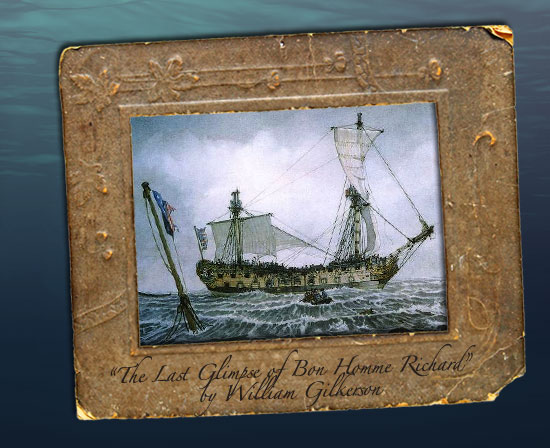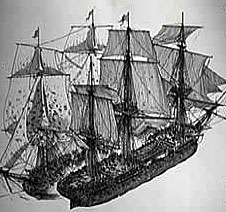
The History of the H.M.S. Serapis
In 1779, England was embroiled in a bitter political and military conflict with its colonies in the New World and their French allies. While this crisis period, known as the American Revolution, is commonly thought to have been confined to American soil, many of the war's important events took place in foreign oceans and lands. A significant event was the unlikely capture of the English warship H.M.S. Serapis by John Paul Jones, who is credited as the Father of the American Navy. This historic Revolutionary War engagement fought on the North Sea, off Flamborough Head, England, is one of the most famous events in naval history. Jones' victory over "impossible" odds won him immortality in the chronicles of American History while his attributed quote, "I have not yet begun to fight," became the universal battle cry for the underdog.
Built in England, Serapis was a powerful frigate, designed for unprecedented versatility and power in ocean battles. On what was her only voyage under the British flag, Serapis was launched on her maiden voyage in mid-1779 with orders to protect the Baltic Merchant Fleet from piracy. On September 23, 1779, John Paul Jones stood issuing battle orders from the deck of the French Bon Homme Richard as the ship was locked in battle with Serapis.
 Jones eventually won the day, captured Serapis and successfully transferred his crew off the fatally damaged Bon Homme Richard. Ironically, it was the first time in naval history that colors were surrendered to a sinking ship. Aboard Serapis, Jones and his fleet limped into Texel, a Dutch port. But his triumph was short lived as British and French diplomats immediately pressured the neutral Dutch government for possession of Jones' prize. Soon the entire fleet was placed under the French flag, except for the American-built ship Alliance, on which Jones was allowed to return home. Although the outcome was less than satisfactory to Jones, news of the event quickly circulated as a worldwide media story while songs and poems were written about the battle. This coverage helped solidify the commitment of the American patriots and encouraged them as they waged war against Great Britain.
Jones eventually won the day, captured Serapis and successfully transferred his crew off the fatally damaged Bon Homme Richard. Ironically, it was the first time in naval history that colors were surrendered to a sinking ship. Aboard Serapis, Jones and his fleet limped into Texel, a Dutch port. But his triumph was short lived as British and French diplomats immediately pressured the neutral Dutch government for possession of Jones' prize. Soon the entire fleet was placed under the French flag, except for the American-built ship Alliance, on which Jones was allowed to return home. Although the outcome was less than satisfactory to Jones, news of the event quickly circulated as a worldwide media story while songs and poems were written about the battle. This coverage helped solidify the commitment of the American patriots and encouraged them as they waged war against Great Britain.
Sometime later, the French navy commissioned Serapis, under Captain Roche, to assist in a campaign to wrest India from British rule. Roche proceeded to the French fort Isle Ste. Marie, located off the northern coast of Madagascar. While Roche was ashore, a lieutenant and a subordinate went below deck to obtain the daily brandy ration for the sailors. While the men were "cutting" the brandy's full strength with water, their lantern fell into the vat and set the spirit locker on fire. Attempts to extinguish the blaze failed and after two-and-a-half hours, the flames burned through the locker walls and reached the powder magazine. An explosion blew out the stern and the vessel sank.
The vagaries of time and sea had all but erased the whereabouts of the Serapis until it was discovered in November 1999 by American nautical archaeologist, Richard Swete and his associate Michael Tuttle. After years of research and a systematic magnetometer survey of the harbor on Isle Ste. Marie, Swete and a team of archaeologists discovered the remains of Serapis.



